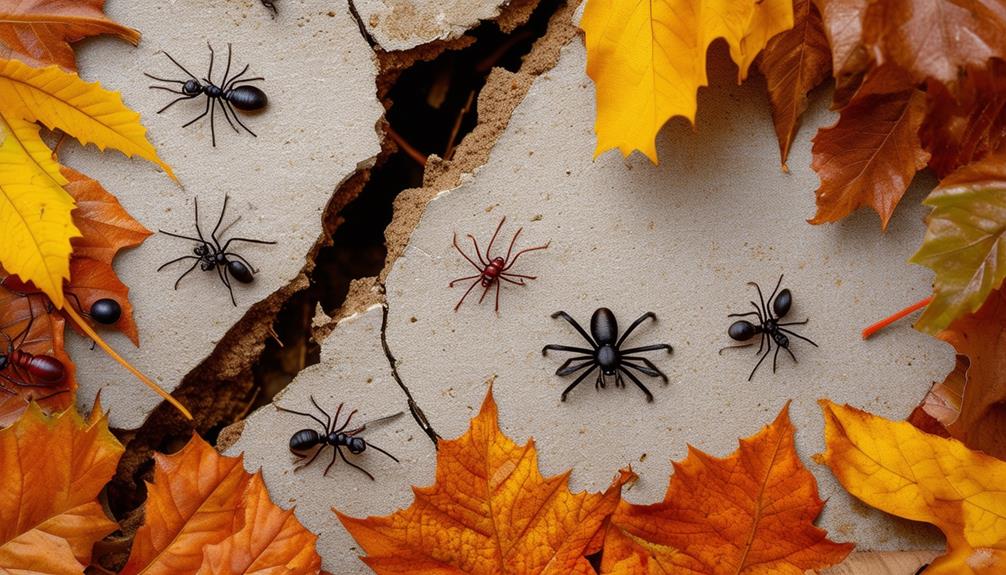The presence of baby roaches after extermination can be a frustrating and perplexing experience for homeowners. Despite efforts to eliminate these pests, their reappearance raises questions about the effectiveness of the extermination process.
In order to understand why baby roaches are still being observed, it is important to consider various factors that may contribute to their survival and resurgence. This article aims to provide an objective analysis of potential explanations for the persistence of baby roaches following extermination, drawing upon scientific knowledge and professional expertise in the field of pest control.
By exploring the reproductive and life cycle of roaches, as well as considering incomplete extermination techniques, reinfestation from neighboring areas, hiding places and nesting habits of baby roaches, and residual effects of extermination products, homeowners can gain a deeper understanding of the complex factors at play.
Ultimately, this knowledge can assist in making informed decisions and seeking effective solutions to address the presence of baby roaches in the home.
Key Takeaways
- Incomplete extermination methods may not target all stages of roach reproduction, leading to the survival of eggs and nymphs.
- Roach eggs and nymphs are resilient and can survive harsh conditions, allowing them to replenish the population.
- Inadequate treatment techniques and improper pesticide application can contribute to incomplete extermination.
- Hiring a professional exterminator can ensure a thorough and effective approach to roach control, including identifying specific species and providing prevention tips for future infestations.
Understanding Roach Reproduction and Life Cycle
The life cycle of roaches involves multiple stages, including egg, nymph, and adult, which may explain the presence of baby roaches even after extermination.
Roach breeding habits contribute to their ability to quickly repopulate an area. Female roaches can produce up to 400 eggs in their lifetime, and these eggs are often laid in hidden, protected areas.
After hatching, the nymphs go through several molts before reaching adulthood.
It is important to note that extermination methods may not always effectively target all stages of the roach life cycle, allowing for the survival of eggs and nymphs.
To prevent roach infestations, it is crucial to address factors that attract roaches, such as food and water sources. Maintaining a clean environment, sealing cracks and crevices, and using baits or insecticides can help in controlling roach populations effectively.
Surviving Roach Eggs and Nymphs
Despite the extermination process, the presence of hatched roach eggs and nymphs remains apparent. Roach egg hatching and nymph survival are intricate processes that contribute to the persistence of these pests.
Roach eggs are typically laid in protected areas like cracks and crevices, making them difficult to detect and eliminate during extermination. These eggs are resilient and can survive harsh conditions, ensuring the continuation of the roach population.
Once the eggs hatch, nymphs emerge and undergo several molting stages before reaching adulthood. Nymphs are small, agile, and adept at hiding, allowing them to evade extermination efforts.
Additionally, roaches have a fast reproductive rate, with females producing multiple egg cases throughout their lifespan. Therefore, even after extermination, it is not uncommon to observe baby roaches, as surviving eggs and nymphs continue to replenish the population.
Incomplete Extermination Techniques
Incomplete extermination techniques often result in the persistence of roach eggs and nymphs, leading to the ongoing population replenishment. One of the reasons why baby roaches may still be seen after extermination is due to inadequate treatment methods. If the treatment did not target all the areas where roaches may hide or breed, some eggs and nymphs may have been left untouched.
Additionally, improper pesticide application can also contribute to incomplete extermination. If the pesticide is not applied correctly or in sufficient amounts, it may not effectively kill all the roaches and their offspring. Furthermore, using the wrong type of pesticide or not following the recommended treatment schedule can also lead to incomplete extermination.
Therefore, it is crucial to employ thorough and appropriate extermination techniques to effectively eliminate roach populations and prevent their resurgence.
Reinfestation from Neighboring Areas
Reinfestation from neighboring areas can occur when roaches migrate from nearby infested locations, potentially leading to a resurgence in population. To prevent reinfestation, it is important to take proactive measures.
One effective approach is to identify and seal off potential entry points such as cracks, crevices, and gaps in walls, floors, and windows.
Additionally, keeping the living space clean and free of food debris will discourage roaches from seeking shelter and sustenance.
Natural remedies can also be used as a preventive measure, such as diatomaceous earth, which is a non-toxic substance that can be sprinkled in areas where roaches are likely to travel.
Furthermore, ensuring proper waste management and promptly fixing any plumbing or moisture issues will help eliminate potential roach habitats.
By implementing these preventive measures, the likelihood of reinfestation from neighboring areas can be significantly reduced.
Hiding Places and Nesting Habits of Baby Roaches
Hiding places and nesting habits of juvenile cockroaches are important to understand in order to effectively control their population. Cockroach behavior plays a crucial role in preventing roach infestations.
Baby roaches, also known as nymphs, seek out warm, dark, and moist environments to hide and nest. Common hiding places for baby roaches include cracks and crevices in walls, cabinets, and furniture, as well as behind appliances and under sinks. They are also known to hide in cluttered areas such as basements and storage rooms.
Nymphs are attracted to food sources, so it is essential to keep kitchens and dining areas clean and free of crumbs and spills. Regular vacuuming and cleaning of these areas can help eliminate potential hiding spots for baby roaches. Additionally, sealing cracks and crevices can prevent their entry and nesting.
By understanding the hiding places and nesting habits of baby roaches, individuals can take proactive measures to prevent reinfestation and effectively control their population.
Residual Effects of Extermination Products
The previous subtopic discussed the hiding places and nesting habits of baby roaches, which are often found in dark and secluded areas. However, even after extermination, it is not uncommon to continue seeing baby roaches in the vicinity.
This can be attributed to the residual effects of extermination products used. Extermination products typically contain chemicals that are designed to eliminate roaches, but these chemicals may leave behind residue that can persist for some time. The residue can have varying levels of toxicity, depending on the specific product used.
While these residues may not be immediately lethal to baby roaches, they can still affect their behavior and growth. Additionally, some baby roaches may have been in eggs or protected areas during the initial extermination, and they can hatch or emerge later, leading to the continued presence of baby roaches.
It is important to understand that complete eradication of baby roaches may take time and repeated treatments.
Hiring a Professional Exterminator for Effective Results
Professional exterminators can be hired to ensure effective eradication of roach infestations. Exterminators have the knowledge, experience, and access to specialized products that can target and eliminate roaches effectively. They are trained to identify the specific species of roaches and determine the most suitable treatment plan.
In addition to their expertise, professional exterminators can provide valuable prevention tips for roach infestations. They can advise on sealing cracks and crevices, removing food and water sources, and maintaining cleanliness. These preventive measures can help individuals take proactive steps to prevent future infestations.
By hiring a professional exterminator, individuals can not only address the current roach infestation but also take proactive measures to prevent future infestations. This ensures a more thorough and effective approach to roach control.
Frequently Asked Questions
Can baby roaches survive without their parents?
Baby roaches, also known as nymphs, are capable of surviving without their parents. They have the ability to reproduce and establish their own colonies, which may explain why you are seeing baby roaches after extermination. Their survival and reproductive capabilities contribute to their persistence in infested areas.
How long does it take for baby roaches to become adults?
The timeframe for roach maturation varies depending on environmental factors such as temperature and food availability. On average, it takes around 2-6 months for baby roaches to become adults.
Are baby roaches more difficult to exterminate than adult roaches?
The effectiveness of exterminating baby roaches compared to adult roaches depends on the chosen method. Implementing prevention strategies, such as proper sanitation and sealing entry points, can help in preventing infestations of both baby and adult roaches.
Can baby roaches infest neighboring areas?
Baby roaches can infest neighboring areas as they are capable of crawling through small cracks and crevices. To prevent this, it is important to implement effective pest control measures and eliminate potential entry points in order to minimize the risk of roach infestations in adjacent areas.
How long do the residual effects of extermination products last?
The residual effects of extermination products can vary depending on the specific product used and the conditions of the infested area. It is important to consult with a professional for accurate information on the duration of these effects.





